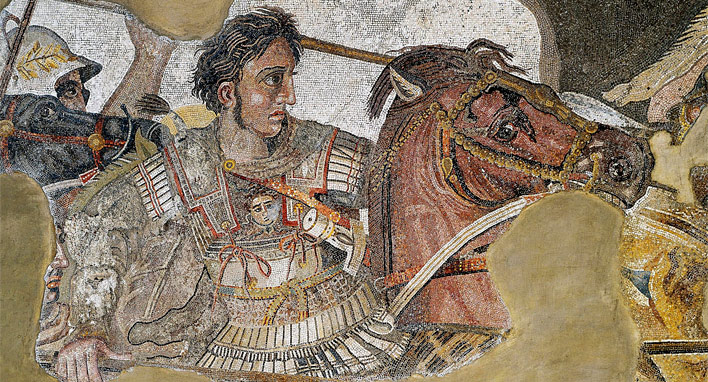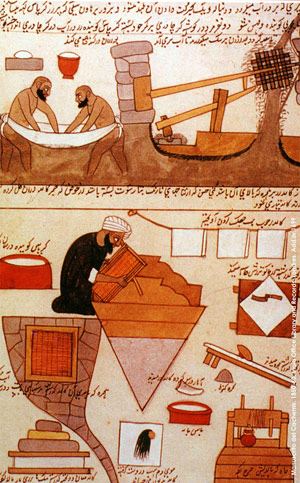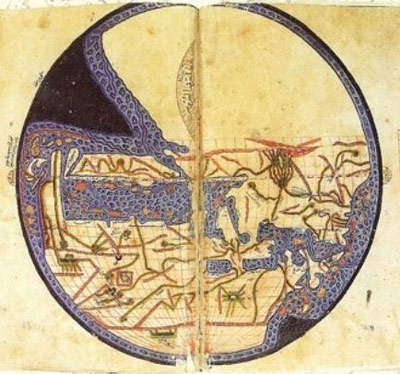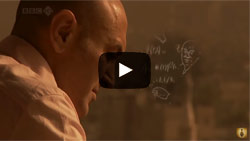
From Rome to Baghdad—The Golden Age of Islam
Rome’s decline, followed by the disastrous Byzantine wars with Persia, left a vacuum into which the Muslim invaders stepped, taking over the land and ideas of the peoples they conquered, including their accumulated resources of Greek literature, philosophy and sciences.
For the first time since Alexander the Great, and for a much longer period, Arab conquests enabled the reunification of territories such as Egypt and the Fertile Crescent with Persia and India politically, administratively and, above all, economically.
The expansion of the Arab Empire in the years following the Prophet Muhammad’s death in 632 CE led to the creation of caliphates occupying vast geographical areas. By the end of the seventh century CE, the Umayyad caliphate’s armies had swept across North Africa. In 711, under general Tariq Ibn Ziyad, they crossed over into Spain. Arab expansion beyond France was halted by Charles Martel at the Battle of Tours in 732. As Al-Khalili says in his definitive work The House of Wisdom, “By this time the Islamic Empire covered an area larger in expanse than either the Roman Empire at its height or all the lands conquered and ruled by Alexander the Great.”
The cultural center of what would become our Western heritage moved from Rome and Constantinople to cities in the Islamic world, the most famous of which were Baghdad and Cordoba. In 750 the Abbasids overthrew the Umayyad Dynasty, and in 762 they moved the capital of the Islamic world from Damascus to Baghdad. During the reigns of the Abbasid caliphs al-Mahdi and his son, the caliph Harun Al-Rashid (the same caliph who figures in many stories of the Arabian Nights), Baghdad became the magnet for the greatest intellects of the time. It was home not only to Muslims but to Christians, Jews, Hindus and Zoroastrians, attracting immigrants from the Middle East, Central Asia, Spain and beyond.
Islamic culture favored learning and tolerance, two major factors that set the stage for the Arab “Golden Age.” The Prophet Muhammad, whose sayings were well-known in the Muslim world, is on record as encouraging learning. For example: “The ink of the scholar is holier than the blood of the martyr.” “The pursuit of knowledge is obligatory on every Muslim.” “Seek knowledge even as far as China.” Muhammad saw himself not as bringing the world a new faith, but as the last of the prophets in a “chain of transmission” that included Abraham, Moses and Jesus. Accordingly, the “People of the Book” merited protection and respect. Tolerance is fundamental to Islamic teaching; without tolerance, it is unlikely that there could have been the convivencia (coming together) that led to the intellectual and scientific flowering that would later be imported and incorporated into Western culture.
Under Arab rule, scholars applied themselves directly to original Greek sources or to translations of them. Most of the first translations into Arabic were made by Christians from the many Greek books that were already extant in Iraq in Syriac translations. Greek texts were brought to Baghdad from Syria, Bactria, India, Persia and elsewhere. Translations might be made several times, each version correcting errors in previous translations as the content became better understood.
The transmission, processing and amplification of knowledge included translations of Sanskrit and Persian works. By the seventh century, Muslims came into direct contact with the surviving Hellenistic cultures of the Near East, connecting, for example, with Christian Syriac writers, scholars and scientists, and later with sources in the central and Western Mediterranean.
From about the middle of the eighth century to the end of the tenth, almost all non-literary and non-historical secular Greek books—including philosophical works—that were available throughout the eastern Byzantine Empire and the Near East were translated into Arabic, which became the second classical language, after Greek.
The Arabs were not passive caretakers who merely held Greek knowledge for later transmission to the West. Rather, they took it and developed it further, in massive state-run enterprises that were carried out by some of the brightest minds in history. In effect, Arab civilization at its peak achieved what the Arabic inscription on the wall of King Abd ar-Rahman’s Great Mosque in Cordoba says: “It embodied what came before. Illuminated what came after.”
The House of Wisdom and the Translation Movement
“The Graeco-Arabic translation movement of Baghdad constitutes a truly epoch-making stage, by any standard, in the course of human history. It is equal in significance to, and belongs to the same narrative as, I would claim, that of Pericles’ Athens, the Italian Renaissance, or the scientific revolution of the sixteenth and seventeenth centuries, and it deserves so to be recognized and embedded in our historical consciousness.” (Dimitri Gutas, Greek Thought, Arabic Culture)
The translation movement really took wing when, in the eighth century, an academy called the House of Wisdom (Bayt al-Ḥikmah) was established by Harun al-Rashid’s son, Abu al-Abbas Abdallah ibn Harun al-Rashid, better known by his regnal name al-Ma’mun. It’s not known whether there really was a single physical House of Wisdom or multiple locations, but there was certainly an institution by that name. Al-Ma’mun was a great patron of science and scholarship, and went to considerable lengths to acquire Greek, Indian and Persian texts—including those by Aristotle, Euclid and Ptolemy—and have them translated into Arabic.
The explosion in translation activity was the result of a combination of factors, including the lifting of both political and religious barriers between the East and the West. Scholars and experts from many countries, fields and cultures were able to contribute, learn and work together. A tremendous interest in Persian knowledge stimulated the translation of Persian texts into Arabic. Al-Ma’mun was half-Persian, and his Persian tutor, Jafar, instilled in his pupil a love for learning. There was a focus on astrology, not only because of Al-Ma’mun’s personal interest in it, but also because he knew that he needed the support of the Persian aristocracy, and astrology was, as Al-Khalili says, “embedded in the Persian culture, and played a fundamental role in Persian daily life.” Interest in it led in part to an interest in other sciences; astrology did not begin its demotion from the Arab scientific worldview until the mid-ninth century.

The most significant contribution to this amazing translation period was the introduction of paper from China. Prior to that time, Arabs and Persians used the more cumbersome and expensive papyrus or parchment made from the skin of animals. Samarkand, a Central Asian center of learning in the Persian Empire, continued to be a center of learning under the Abbasids. When the Chinese were defeated by the Muslim army in 751, Chinese prisoners of war with knowledge of papermaking were taken back to Samarkand. Situated along the Silk Road between China and the West, Samarkand was the site of the first paper mill of the Abbasid Empire. By the end of the eighth century, Baghdad had paper mills, and an entire street in Baghdad’s city center was devoted to the sale of paper and books. Less expensive than papyrus or parchment, paper was a vital element in the efficient growth of the empire’s expanding bureaucracy.
By the ninth century Baghdad was the largest city in the world with dozens of multi-storied elaborate palaces for the caliph, his family and their entourage, as well as libraries, administrative buildings, broad avenues, boulevards, and gardens. Complex canals carrying water into the city from the Tigris ensured adequate irrigation and water for all purposes. Construction projects made mathematical knowledge essential, as were astronomical studies, since they provided both the direction of Mecca to which all Muslims pray five times a day and the times for those daily prayers, plus they accurately determined the beginning and end of Ramadan, the month of fasting.
The end result of the confluence of these factors was that in caliph Al-Ma’mun’s time, the translation movement became a truly massive undertaking by people of multiple faiths, one in which tolerance trumped religious affiliations in favor of learning. To quote Al-Khalili’s The House of Wisdom again, “The greatest of all the translators of Baghdad, Hunayn ibn Ishāq, was a Nestorian who never converted to Islam. Other Christian scientists of ninth-century Baghdad include the astronomer Yahya ibn abi Mansūr and the physicians Jibrīl ibn Bakhtyashū and Ibn Massāwayh. Likewise, many Jewish philosophers and scientists, such as the translator Sahl al-Tabari, the medic Ishāq ibn Amrān and the astronomer Mashā’allah, all made valuable contributions to the intellectual culture of Baghdad.”

Al-Ma’mun favored the Mu’tazilites, who sought to combine faith and reason and encouraged a spirit of scientific inquiry. He was very likely the first head of state in history to bring together a diverse group of scientists with expertise in mathematics, astronomy and geography, working together at the first astronomical observatory in the Islamic world. There they checked Ptolemy’s astronomical tables, made their own observations and produced a new set called the “Verified Tables.” Al-Ma’mun commissioned scientists to determine an accurate value for the circumference of the Earth. (The conclusion was 24,500 miles, very close to the correct value of 24,901 miles. Eratosthenes, a Greek who lived from around 275 BCE to 195 BCE, got even closer, with a value of 24,900 miles, but some believe this was due to luck, since his method included guesswork.) Al-Ma’mun also ordered a mapmaking enterprise that would have a tremendous impact on the field of mathematical geography. His team of scientists came up with a map of the world that showed the locations of important cities and landmarks, correcting the geographical data in Ptolemy’s Geographia.
In the series: The Journey of Classical Greek Culture to the West
Further Reading »
External Stories and Videos


Watch: Science & Islam
BBC full series with Jim Al-Khalili
The history of Islamic science and it’s subsequent spread through Europe.
